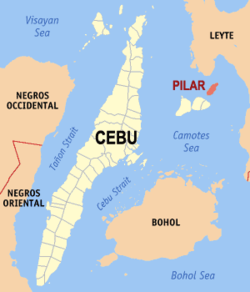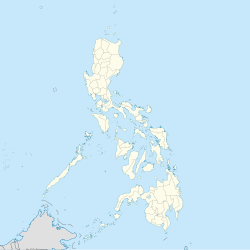Pilar, Cebu
Pilar | |
|---|---|
| Municipality of Pilar | |
 Map of Cebu with Pilar highlighted | |
Location within the Philippines | |
| Coordinates: 10°48′25″N 124°33′54″E / 10.807°N 124.565°E | |
| Country | Philippines |
| Region | Central Visayas |
| Province | Cebu |
| District | 5th district |
| Barangays | 13 (see Barangays) |
| Government | |
| • Type | Sangguniang Bayan |
| • Mayor | Manuel P. Santiago |
| • Vice Mayor | Chiziline S. Maratas |
| • Representative | Vincent Franco D. Frasco |
| • Municipal Council | Members |
| • Electorate | 9,434 voters (2022) |
| Area | |
| • Total | 32.42 km2 (12.52 sq mi) |
| Elevation | 19 m (62 ft) |
| Highest elevation | 615 m (2,018 ft) |
| Lowest elevation | 0 m (0 ft) |
| Population (2020 census)[3] | |
| • Total | 12,506 |
| • Density | 390/km2 (1,000/sq mi) |
| • Households | 3,360 |
| Economy | |
| • Income class | 5th municipal income class |
| • Poverty incidence | 45.33 |
| • Revenue | ₱ 66.4 million (2020) |
| • Assets | ₱ 206.7 million (2020) |
| • Expenditure | ₱ 70.65 million (2020) |
| • Liabilities | ₱ 65.66 million (2020) |
| Service provider | |
| • Electricity | Camotes Electric Cooperative (CELCO) |
| Time zone | UTC+8 (PST) |
| ZIP code | 6048 |
| PSGC | |
| IDD : area code | +63 (0)32 |
| Native languages | Cebuano Tagalog |
Pilar, officially the Municipality of Pilar (Cebuano: Lungsod sa Pilar; Tagalog: Bayan ng Pilar), is a 5th class municipality in the province of Cebu, Philippines. According to the 2020 census, it has a population of 12,506 people.[3]
The municipality is contiguous with Ponson Island, one of the four Camotes Islands in the Camotes Sea (along with Pacijan Island, Poro Island, and Tulang Island). The island is about 10.6 kilometres (6.59 mi) long and 3.7 kilometres (2.30 mi) wide.
Geography
[edit]Barangays
[edit]
Pilar is politically subdivided into 13 barangays. Each barangay consists of puroks and some have sitios.
| PSGC | Barangay | Population | ±% p.a. | |||
|---|---|---|---|---|---|---|
| 2020[3] | 2010[5] | |||||
| 072236001 | Biasong | 2.8% | 345 | 360 | −0.42% | |
| 072236002 | Cawit | 15.4% | 1,925 | 1,892 | 0.17% | |
| 072236003 | Dapdap | 4.5% | 563 | 781 | −3.22% | |
| 072236004 | Esperanza | 6.5% | 815 | 851 | −0.43% | |
| 072236015 | Imelda | 4.7% | 582 | 616 | −0.57% | |
| 072236005 | Lanao | 8.2% | 1,029 | 990 | 0.39% | |
| 072236006 | Lower Poblacion | 6.0% | 745 | 578 | 2.57% | |
| 072236007 | Moabog | 8.3% | 1,034 | 1,007 | 0.26% | |
| 072236008 | Montserrat | 9.6% | 1,202 | 1,303 | −0.80% | |
| 072236011 | San Isidro | 3.9% | 482 | 570 | −1.66% | |
| 072236012 | San Juan | 5.8% | 730 | 799 | −0.90% | |
| 072236013 | Upper Poblacion | 6.9% | 865 | 770 | 1.17% | |
| 072236014 | Villahermosa | 7.9% | 991 | 1,047 | −0.55% | |
| Total | 12,506 | 11,564 | 0.79% | |||
Climate
[edit]| Climate data for Pilar, Cebu | |||||||||||||
|---|---|---|---|---|---|---|---|---|---|---|---|---|---|
| Month | Jan | Feb | Mar | Apr | May | Jun | Jul | Aug | Sep | Oct | Nov | Dec | Year |
| Mean daily maximum °C (°F) | 28 (82) |
29 (84) |
29 (84) |
30 (86) |
30 (86) |
30 (86) |
29 (84) |
29 (84) |
29 (84) |
29 (84) |
29 (84) |
29 (84) |
29 (84) |
| Mean daily minimum °C (°F) | 22 (72) |
22 (72) |
22 (72) |
23 (73) |
25 (77) |
25 (77) |
25 (77) |
25 (77) |
25 (77) |
24 (75) |
24 (75) |
23 (73) |
24 (75) |
| Average precipitation mm (inches) | 78 (3.1) |
57 (2.2) |
84 (3.3) |
79 (3.1) |
118 (4.6) |
181 (7.1) |
178 (7.0) |
169 (6.7) |
172 (6.8) |
180 (7.1) |
174 (6.9) |
128 (5.0) |
1,598 (62.9) |
| Average rainy days | 16.7 | 13.8 | 17.3 | 18.5 | 23.2 | 26.5 | 27.1 | 26.0 | 26.4 | 27.5 | 24.6 | 21.0 | 268.6 |
| Source: Meteoblue[6] | |||||||||||||
Demographics
[edit]| Year | Pop. | ±% p.a. |
|---|---|---|
| 1903 | 4,461 | — |
| 1918 | 5,213 | +1.04% |
| 1939 | 8,142 | +2.15% |
| 1948 | 8,663 | +0.69% |
| 1960 | 8,816 | +0.15% |
| 1970 | 9,541 | +0.79% |
| 1975 | 10,624 | +2.18% |
| 1980 | 11,126 | +0.93% |
| 1990 | 11,499 | +0.33% |
| 1995 | 11,191 | −0.51% |
| 2000 | 11,226 | +0.07% |
| 2007 | 11,941 | +0.86% |
| 2010 | 11,564 | −1.16% |
| 2015 | 11,308 | −0.43% |
| 2020 | 12,506 | +2.00% |
| Source: Philippine Statistics Authority[7][5][8] | ||
Language
[edit]People in Pilar mainly speak Cebuano with an accent similar to the locals of Bohol. Like most Filipinos, Pilaranons may also speak Tagalog and English. Waray is also spoken due to its proximity to Leyte.
The town is home to the Porohanon language, one of the most endangered languages in the Visayas. The language is only used in the Poro islands. The language is classified as distinct from Sebwano (Bisaya) by the Komisyon ng Wikang Filipino and is vital to the culture and arts of the Porohanon people.
Economy
[edit]Poverty incidence of Pilar
10
20
30
40
50
2006
42.70 2009
48.87 2012
30.80 2015
31.85 2018
23.50 2021
45.33 Source: Philippine Statistics Authority[9][10][11][12][13][14][15][16] |
References
[edit]- ^ Municipality of Pilar | (DILG)
- ^ "2015 Census of Population, Report No. 3 – Population, Land Area, and Population Density" (PDF). Philippine Statistics Authority. Quezon City, Philippines. August 2016. ISSN 0117-1453. Archived (PDF) from the original on May 25, 2021. Retrieved July 16, 2021.
- ^ a b c Census of Population (2020). "Region VII (Central Visayas)". Total Population by Province, City, Municipality and Barangay. Philippine Statistics Authority. Retrieved 8 July 2021.
- ^ "PSA Releases the 2021 City and Municipal Level Poverty Estimates". Philippine Statistics Authority. 2 April 2024. Retrieved 28 April 2024.
- ^ a b Census of Population and Housing (2010). "Region VII (Central Visayas)" (PDF). Total Population by Province, City, Municipality and Barangay. National Statistics Office. Retrieved 29 June 2016.
- ^ "Pilar: Average Temperatures and Rainfall". Meteoblue. Retrieved 10 May 2020.
- ^ Census of Population (2015). "Region VII (Central Visayas)". Total Population by Province, City, Municipality and Barangay. Philippine Statistics Authority. Retrieved 20 June 2016.
- ^ Censuses of Population (1903–2007). "Region VII (Central Visayas)". Table 1. Population Enumerated in Various Censuses by Province/Highly Urbanized City: 1903 to 2007. National Statistics Office.
- ^ "Poverty incidence (PI):". Philippine Statistics Authority. Retrieved December 28, 2020.
- ^ "Estimation of Local Poverty in the Philippines" (PDF). Philippine Statistics Authority. 29 November 2005.
- ^ "2003 City and Municipal Level Poverty Estimates" (PDF). Philippine Statistics Authority. 23 March 2009.
- ^ "City and Municipal Level Poverty Estimates; 2006 and 2009" (PDF). Philippine Statistics Authority. 3 August 2012.
- ^ "2012 Municipal and City Level Poverty Estimates" (PDF). Philippine Statistics Authority. 31 May 2016.
- ^ "Municipal and City Level Small Area Poverty Estimates; 2009, 2012 and 2015". Philippine Statistics Authority. 10 July 2019.
- ^ "PSA Releases the 2018 Municipal and City Level Poverty Estimates". Philippine Statistics Authority. 15 December 2021. Retrieved 22 January 2022.
- ^ "PSA Releases the 2021 City and Municipal Level Poverty Estimates". Philippine Statistics Authority. 2 April 2024. Retrieved 28 April 2024.
External links
[edit]


